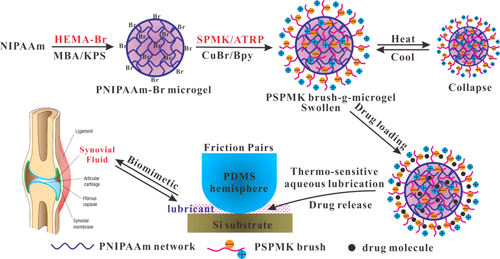The interfacial friction of soft matter is mostly found in living things and its friction coefficient is extremely low. The ultra-low friction coefficient helps living things to better adapt to the environment and survive from attack. This prompts researchers to wonder whether people can achieve this low friction while have a control over its friction coefficient as well.
Inspired by this, the group headed by Prof. ZHOU Feng at the State Key Laboratory of Solid Lubrication of the Lanzhou Institute of Chemical Physics (LICP) of the Chinese Academy of Sciences (CAS) prepared several responsive soft materials by introducing responsive molecular groups into material substrates. Under external stimuli, the surface molecular conformation of the as-prepared materials is transformed and the regulation of interfacial friction can be realized. In this way, the newly prepared materials show promising friction properties.
Firstly, the researchers prepared a series of thermal-sensitive hydrogels and achieved the reversible friction regulation by changing the test temperature (Macromol. Rapid Commun., 2013, 34, 1785-1790). And then, they injected another pH-sensitive monomer into the thermal-sensitive hydrogels to endow them with multi-stimuli responsiveness (temperature & pH). This gel not only has an ultra-low friction but its friction coefficient can be continuously regulated from 0.05, and then 0.1, to 1.0 by gradually changing the test temperature and pH, (NPG Asia Mater.,2014, 6, e136;DOI:10.1038/am.2014.82). These reversible and tunable frictional hydrogels have potential application in the design of intelligent control equipment.
Based on the above work, researchers also prepared a series of thermal-responsive microgels and decorated them with functional groups. With the introduction of benzotriazole group into the surface of micro-gels, the micro-gels obtained anti-corrosion characteristic (ACS Appl. Mater. Interfaces,2013,5, 10842?10852). By grafting hydrophilic polymer brush on the microgel surface, the gels showed excellent friction (~0.005) and a desirable temperature-triggered drugs release performance (ACS Appl. Mater. Interfaces,2014, 6, 20452?20463). Such a soft charged hairy microgel offers great possibility for designing intelligent synovial fluid. What is more, the combination of lubrication and drug loading capabilities enables the large clinical potential of novel soft hairy nanoparticles as synthetic joint lubricant fluid in arthritis treatment.

Schematic Illustration for the Fabrication of PSPMK Brushes-Grafted PNIPAAm Microgels, the Drug Loading and Release of the Hairy Spherical Microgels, and the Tribological Process of the Polyelectrolyte Microgels As a Biomimetic Synovial Fluida (Image by ZHOU Feng et al.)
The work has received support from the National Natural Science Foundation of China and Key Research Program of the CAS.


